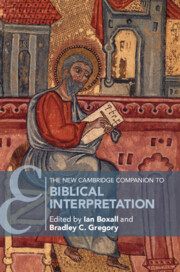Book contents
- The New Cambridge Companion to Biblical Interpretation
- Cambridge Companions to Religion
- The New Cambridge Companion to Biblical Interpretation
- Copyright page
- Contents
- Figures
- Contributors
- Acknowledgments
- Abbreviations
- Introduction
- Part I Methods
- Part II Frameworks/Stances
- Part III Reception
- 15 The Relevance of Textual Criticism for Biblical Interpretation
- 16 Premodern Interpretation and Contemporary Exegesis
- 17 The Bible and Literature
- 18 The Bible and Visual Exegesis
- 19 Uses of the Bible in Communities of Faith
- Scripture Index
- General Index
- Cambridge Companions to Religion
- References
18 - The Bible and Visual Exegesis
from Part III - Reception
Published online by Cambridge University Press: 15 October 2022
- The New Cambridge Companion to Biblical Interpretation
- Cambridge Companions to Religion
- The New Cambridge Companion to Biblical Interpretation
- Copyright page
- Contents
- Figures
- Contributors
- Acknowledgments
- Abbreviations
- Introduction
- Part I Methods
- Part II Frameworks/Stances
- Part III Reception
- 15 The Relevance of Textual Criticism for Biblical Interpretation
- 16 Premodern Interpretation and Contemporary Exegesis
- 17 The Bible and Literature
- 18 The Bible and Visual Exegesis
- 19 Uses of the Bible in Communities of Faith
- Scripture Index
- General Index
- Cambridge Companions to Religion
- References
Summary
This chapter focuses on recent scholarly discussion of how the visual arts may be considered capable of “visual exegesis” (a term first coined by the art historian Paolo Berdini and now widely used). It argues that, when we read the Bible in the company of visual art, we are asked to countenance our implication in each other, in a single world full of many meanings, in the shared conditions that sustain human communication across difference and in the encompassing existential questions that the biblical texts pose.
- Type
- Chapter
- Information
- The New Cambridge Companion to Biblical Interpretation , pp. 335 - 355Publisher: Cambridge University PressPrint publication year: 2022

